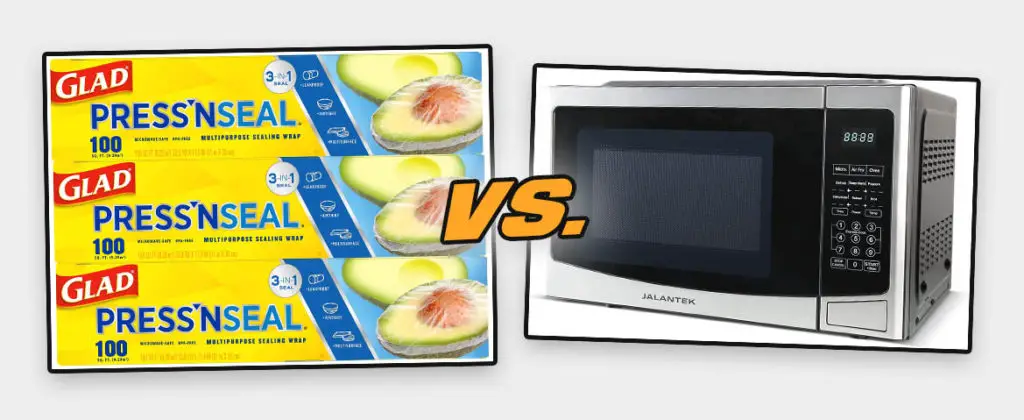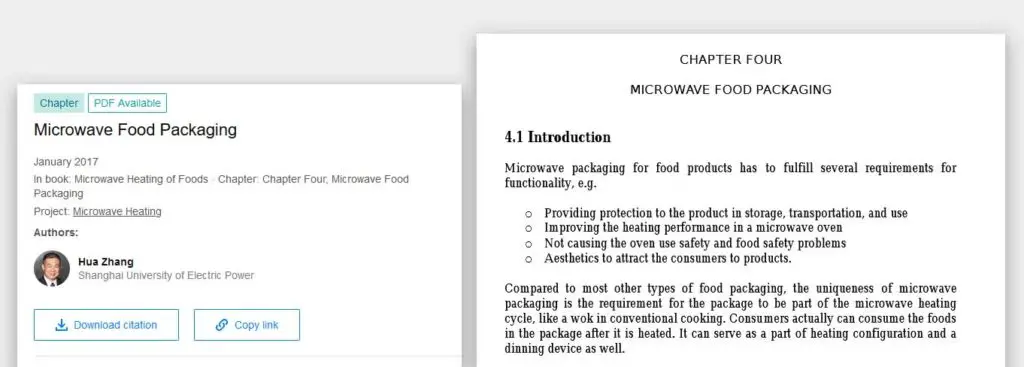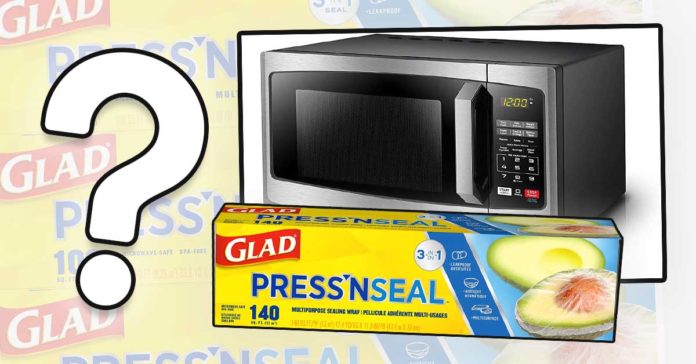Can you use Press and Seal in a microwave? What kind of plastic sealing wrap is microwave safe? How to use Press’n Seal in a microwave? It turns out that while some plastics are reasonably safe to put inside your microwave after taking some precautions, some are definitely not. Let’s go over the most important things when it comes to using microwave-safe plastic wraps inside your microwave oven.
- Can you microwave Press and Seal?
- How to use Press’n Seal inside a microwave?
- Is Press and Seal microwave safe?
- So, can you safely put Press’n Seal in a microwave?
- Can any kind of plastic sealing wrap go in a microwave?
- How to safely use microwave-safe plastic wrap inside your microwave?
- What kind of food packaging materials can be deemed microwave safe?
- I want to know more about food and plastic containers!
This web portal is supported by its readers, and is a part of the Amazon Services LLC Associates Program and the eBay Partner Network. When you buy using links on our site, we may earn an affiliate commission!
Can you microwave Press and Seal?

Glad Press’n Seal is described as microwave safe on their official product site. The site states that Press’n Seal won’t cause a mess and ruin your meal by bending or warping inside your microwave. There are however some precautions you should take while microwaving your food with Press and Seal still on it.
Glad Press and Seal is said to be BPA free and microwave safe, but there are a few things you have to know before microwaving your Press n Seal packed food. – source.
It’s important to note, that one of the most important things while microwaving food with microwave-safe wraps it to always make sure that the wrap isn’t touching the surface of your food products during the microwaving process. More crucial tips in a short while.
How to use Press’n Seal inside a microwave?
The Press’n Seal wrap by itself won’t deform when put inside a working microwave, but when in contact with hot greasy food during the microwaving process it just might. Don’t use press’n seal with overly greasy food, or food rich in fat or sugar. These kinds of food especially shouldn’t come in contact with the microwave-safe plastic wrap.
Ensure that there is at least 1 inch (2.5 cm) gap between your microwave-safe wrap and your prepared food product when it’s put inside the microwave.
This also means that you should not put your food on top of your microwave-safe wrap, but rather, you should only use it to seal the top of your microwave-safe containers if you want to keep all the moisture in. Why? We’ll talk about this in a short while.
For the complete list of steps refer to the “How to safely use microwave-safe plastic wrap inside your microwave?” point down below.
Press and seal is officially labeled as a microwave safe product, but you cannot use it in any kind of conventional oven, with a stove top or in a convection oven. The wrap will then deform, ruin your meal and cause a health hazard.
Is Press and Seal microwave safe?

Is Press ‘n Seal microwave safe? Yes, as we’ve said, according to the official Glad website it is – this means that provided certain conditions are met, it won’t melt, deform or warp when put inside a working microwave oven.
Press’n Seal won’t bend, change its shape, melt or stick to your food during the microwaving process, although you need to meet certain conditions when you’re microwaving your food together with press n seal. All these are mentioned down below.
So, can you safely put Press’n Seal in a microwave?
Yes, if you provide a gap existing between the Press’n Seal wrap’s surface and your food, avoid greasy, high in fat, or high in sugar foods and take a few other precautions, you will be able to safely use it inside your microwave.
It’s also important to leave a venting space somewhere around the seal, so that the seal won’t be airtight and the air pressure won’t rise abruptly inside the sealed container.
Another thing is that while Press’n Seal is a BPA free and microwave-safe product, some people try to reduce their use of plastic containers in a microwave altogether.
This is mainly because there are many ongoing studies connected with using all kinds of plastic containers in microwave ovens. If you’re curious about these, you can check many of them, for example using this Google Scholar query.

These studies on average show that depending on the actual plastic container, the food being prepared, the way the packaging is positioned around it and your microwave’s settings, there might be a chance of unwanted substances to travel from your microwave-safe plastic wrap to your food.
This is one of the reasons why you should always ensure that there is a gap between your food and the microwave-safe wrap, and take special precautions during the microwaving process even when using microwave safe containers.
Can any kind of plastic sealing wrap go in a microwave?

Plastic wrap is safe to use in the microwave in a right way only if it’s labeled as microwave safe food packaging material by its manufacturer.
Certainly not all types of sealing wrap or saran wrap can go inside your microwave. Always check your particular wrap for microwave-safe markings on the package before preparing your meal.
Unless the plastic container is deemed microwave safe on its manufacturer’s website, don’t put it inside your microwave! It might cause serious health issues if you do.
How to safely use microwave-safe plastic wrap inside your microwave?

Here are some rules you need to follow to safely use your microwave-safe wrap in your microwave:
- Double check that the plastic wrap you’re using is really deemed microwave safe by its manufacturer.
- Don’t use microwave-safe wraps with greasy food, food rich in fat or sugar.
- Leave at least a 1-inch (2.5 cm) gap between the microwave-safe plastic wrap and your food. Make sure your food doesn’t touch the wrapping’s surface.
- Don’t place your food on top of the microwave-safe plastic wrap.
- When wrapping the top of any microwave-safe container, leave a slight gap for air and don’t seal your food containers tightly.
- Don’t use high power levels for extended amounts of time when the microwave-safe plastic wrap is inside your microwave oven.
What kind of food packaging materials can be deemed microwave safe?

According to this research paper by Hua Zhang from Shanghai University of Electric Power, there are many materials that can make microwave-safe food containers. Among these materials there are:
- Glass and ceramics.
- Paper and paper board containers.
- Certain kinds of polymer containers.
- Specific kinds of metalized paper and metal trays.
- Various types of edible food packaging.
To be 100% sure that the container you’re planning to use in your microwave is safe and won’t cause you any serious problems you should always refer to its manufacturer’s statements. If a container on its original packaging is not labeled as microwave safe, don’t put it inside your microwave oven.


